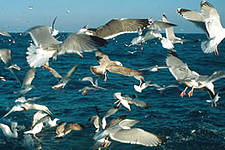Historic high seas declaration at risk
Last minute reservations from four countries may sink the historic announcement of a network of marine protected areas over key areas of the mid-Atlantic Ridge and basin which was scheduled for the North-East Atlantic environment summit later this month.
 |
|
Seabirds, North Atlantic Ocean. |
The declaration, foreshadowed by the OSPAR Commission for the Protection of the Marine Environment of the North-East Atlantic since 2008, would have been the world's first declaration of a suite of protected sites in waters outside any national jurisdiction.
“The sixteen Contracting Parties have been working towards a milestone achievement for several years, setting a global example to protect ocean wildlife and vulnerable habitats in international waters which is considered an unprecedented pilot by other coastal states worldwide," said Stephan Lutter, International Marine Policy Officer with WWF-Germany and WWF’s observer to OSPAR, the Oslo Paris convention on the north east Atlantic environment.
"Now, the reservation by four governments is putting the big break at risk.”
Ministers representing parties to OSPAR were scheduled to consider detailed proposals at a meeting in Bergen, Norway on 20-24 September.
“However now that the draft Decisions and Recommendations are on the table for adoption, a group of countries sadly withdraw their support to what could become a global push for good High Seas and ocean governance," said Lutter. "Due to the reluctance of Denmark, Iceland, Norway and the United Kingdom, the ambitious plan to deliver a first network of High Seas marine protected areas is at stake.”
The new found reluctance of these states to stick to their original commitments is thought to relate to them notifying extensions of their continental shelf beyond the 200 nautical miles Exclusive Economic Zones (EEZs) to the United Nations. These seabed claims now coincide with parts of the proposed marine protected areas.
OSPAR's 2008 agreement in principle designated large sections of the Mid-Atlantic Ridge, the so-called Charlie-Gibbs Fracture Zone as the first High Seas marine protected area. This underwater mountain range and canyon hosts a wealth of deep sea wildlife, from deep water sharks to cold-water coral reefs and sponge formations. In the upper water layer, there is the sub-polar water front rich in plankton and fish, attracting oceanic seabirds and migrating marine mammals such as big whales.
“Since the time of this political milestone agreement, OSPAR has made remarkable progress in terms of carving out specific conservation objectives and starting consultations about the future management of the protected area with the competent UN authorities for fisheries, seabed mining and shipping, another unique and innovative approach deserving global attention,” Lutter said.
Moreover, five additional seamount and ridge sites have been selected and nominated as marine protected areas in the meantime, altogether covering about 450.000 square km or appr. 9% of the North-East Atlantic’s international waters.
WWF disputes the basis of reservations of the four countries. Legal advice, including reports commissioned with Law of the Sea experts by WWF, notes the feasibility of establishing marine protected areas via shared responsibility of coastal states for protection of their seabed and international authorities for adjacent areas.
“We believe that states are even obliged to apply their marine conservation laws up to the offshore limit of their jurisdiction, “ Lutter said, highlighting the example of Portugal which has nominated four of the sites concerned on its extended shelf and is proactively inviting OSPAR to afford protection to the remaining waters.
“We have not abandoned all hope that this example might catch on and not lost faith in the upcoming Ministerial summit keeping its momentum and international credibility.”
Go to Forum >>0 Comments
 Add your comments...
Add your comments...
- User Name Required
- Your Comment
- Racist, abusive and off-topic comments may be removed by the moderator.
 0
0 






